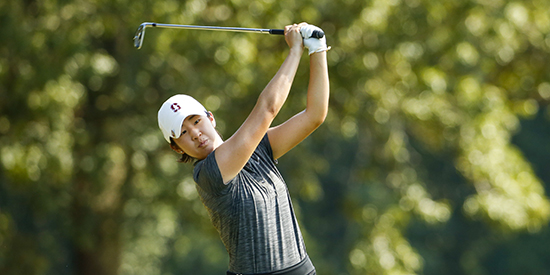
Andrea Lee (USGA/Steve Gibbons)
Once, Andrea Lee was “the kid” at the U.S. Women’s Amateur. The 20-year-old played her first one of these in 2012, as a 13-year-old. The golf world hardly turns its collective heads at that anymore. There are 11 players younger than 16 at Old Waverly Golf Club in West Point, Miss., this week (and 100 players who are 20 or younger).
Having been in that position of having everything to prove, Lee found herself on the opposite side twice in the last 24 hours. The Stanford senior drew the two most dangerous teenagers on the bracket over the past two rounds of match play. It took 23 holes to defeat Alexa Pano, 14, on Thursday evening.
Lee had to come back Friday morning to face 16-year-old Lucy Li. Lee put it away with astonishing efficiency, making three consecutive birdies at Nos. 9-11 on her way to a 6-and-5 victory.
“The putter just kind of felt hot today and I was just rolling them in nicely,” Lee said. “I know that [Lucy] didn’t have her best game today. But I’ll take the win. She’s a great player and I wish her the best of luck in the future, too.”
If not for Lee, there was the potential for a Pano-Li showdown. Expect both to keep contending – and eventually, to win – at this championship. Just not this year.
With Lee still alive, so is the potential for an all-Stanford final. Both Lee and Cardinal classmate Albane Valenzuela need to win one more match on Saturday to meet up on Sunday.
Both have been deep on this bracket enough times to activate a major rooting interest. Valenzuela was runner-up in 2017.
So far this week, Valenzuela has had to take down Sierra Brooks, the runner-up in 2015, plus Brynn Walker, Megan Schofill, and on Friday morning, Aneka Seumanutafa. Valenzuela didn’t make a bogey in the quarterfinals.
“I think I really take it day by day, but I'm really confident with my game,” she said. “I feel more mature as a player compared to 2017, and I wasn't necessarily playing my best golf earlier in the week, but I just relied on my experience, and I think that gave me more success on the course. Hopefully it will continue.”
The most inexperienced player left is Megha Ganne, which isn’t really saying much considering that the 15-year-old played the U.S. Women’s Open earlier this summer and as a graduate of The First Tee of Metropolitan New York, often serves as a mentor in the program.
In a video filmed after she qualified for the Women’s Open, Ganne said her favorite First Tee core value is perseverance. That bodes well for this marathon week.
Ganne got into the semifinals easily enough with three birdies and an eagle for a 3-and-2 defeat of Caroline Canales. It was the first match yet where Ganne hasn’t had to play the full 18 holes.
“It was really weird not having to catch my breath every shot,” said Ganne, who went 18, 19 and 20 holes to win her first three matches. “It was a lot more peaceful today.”
As for afternoon plans?
“I might take a nap.”
Ganne will likely need all the stored-up energy she can muster on Saturday in a semifinal match against reigning North & South Women’s Amateur champion Gabriela Ruffels. The USC player defeated Alabama’s Kenzie Wright on Friday, but not easily. Between them, there were 13 birdies.
“It was crazy,” Ruffels said. “I mean, from the start, she never made any bogeys. I was kind of waiting for her to kind of miss one, mis-hit a shot or something like that, but it didn't happen. She put the pressure on every single hole, and I think every hole was won with a birdie, so it was a really good match.”
At the Women’s Amateur, you make birdies. Or else.
ABOUT THE
U.S. Women's Amateur
The U.S. Women's Amateur, the third
oldest of
the USGA championships, was first played
in 1895
at Meadowbrook Club in Hempstead, N.Y.
The
event is open to any female amateur who
has a
USGA Handicap Index not exceeding 2.4.
The
Women's Amateur is one of 15 national
championships conducted annually by the
USGA.
View Complete Tournament Information